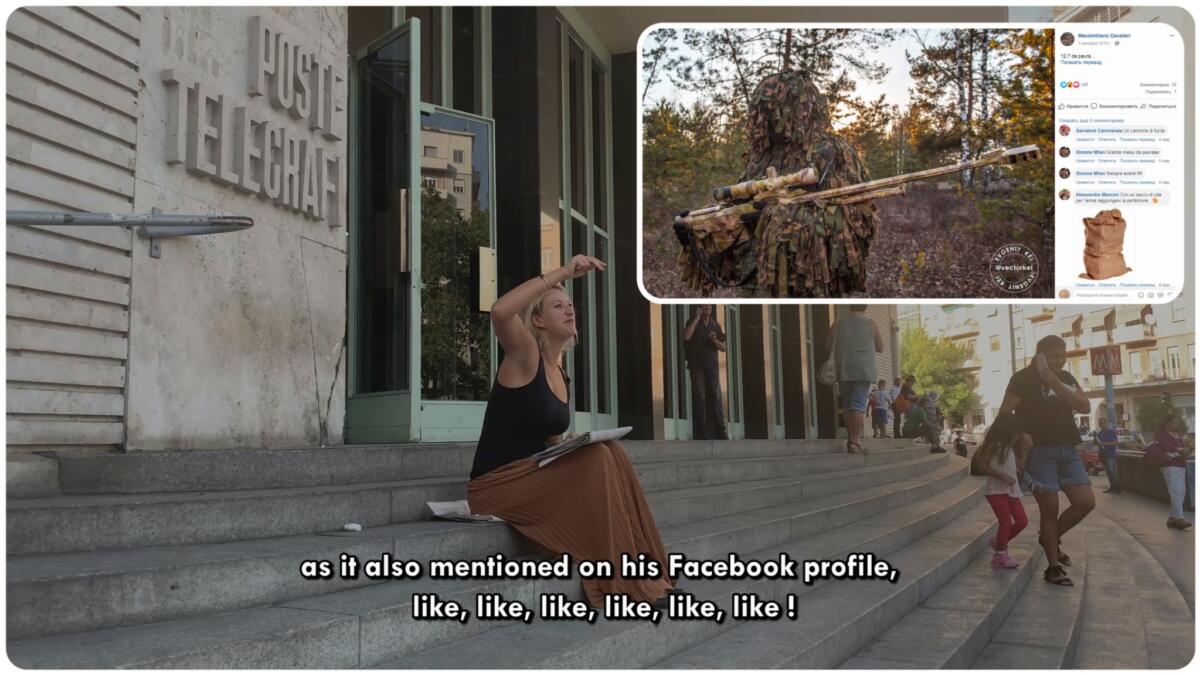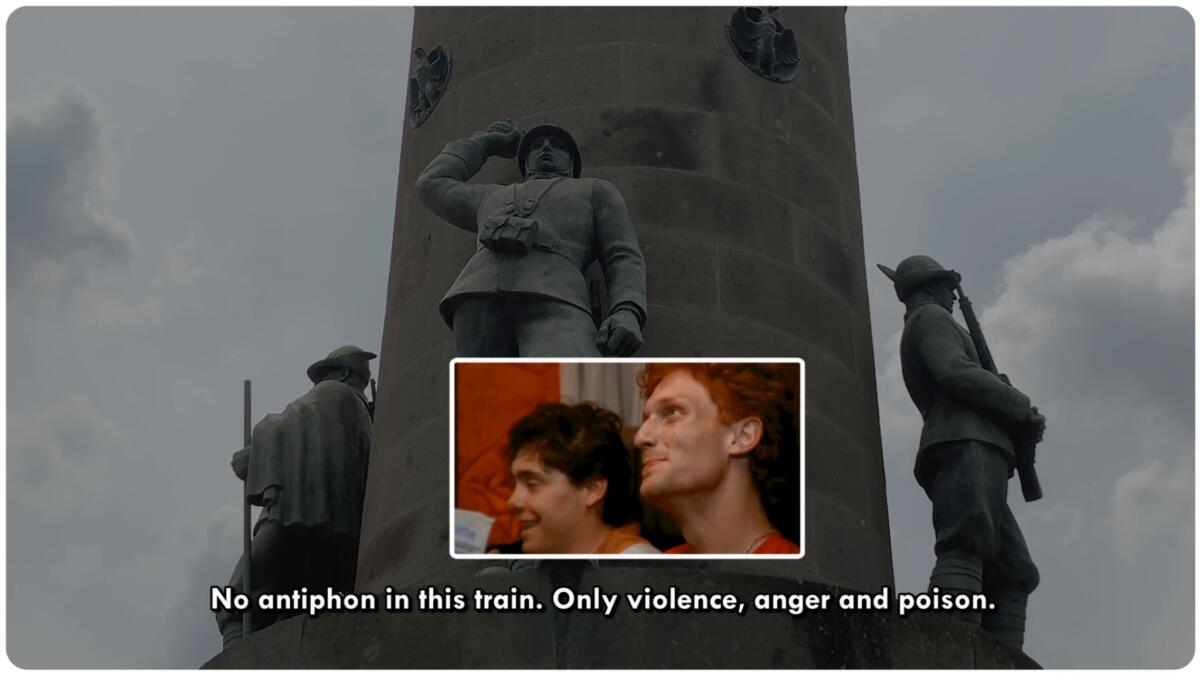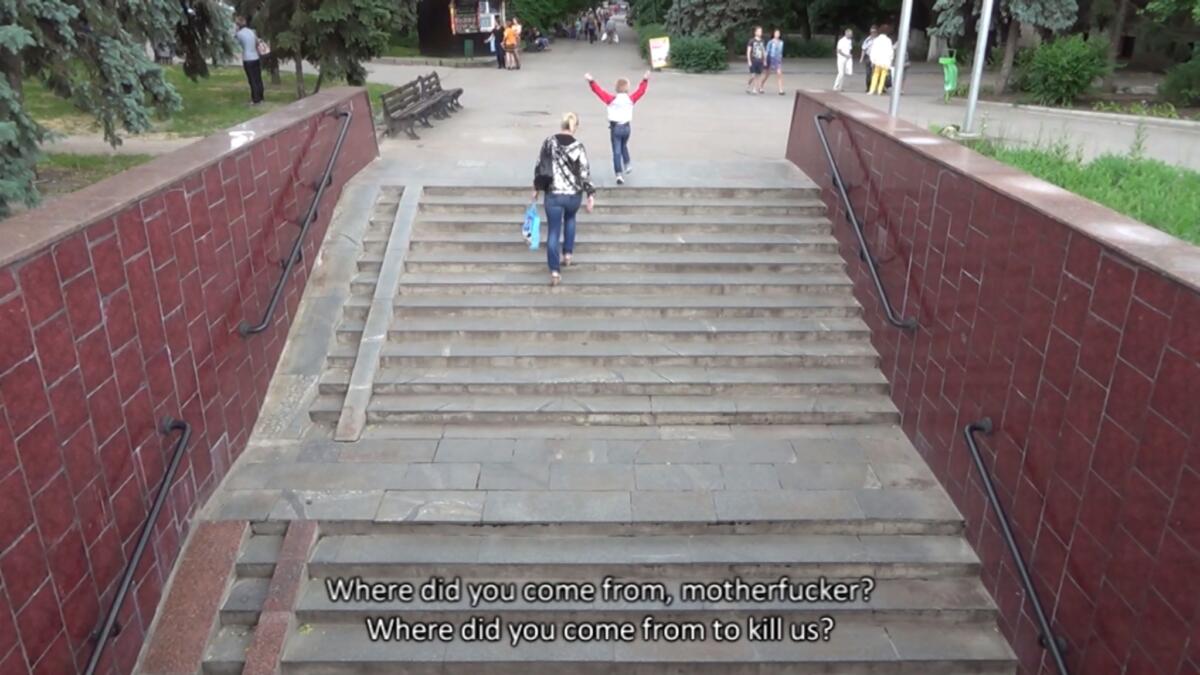
Anna Remešová: You are from Kharkiv, and the topic of the war has been present in your films for a long time. How has the development of the last seven months changed your attitude towards your work and towards documentarism in the moving image?
Mykola Ridnyi: I wouldn’t say that my video works are documentary. It is far from what we know as the genre of documentary, it is rather “documentary-based”. I use different approaches of the moving image to show situations from different angles. My documentary-style observations can be combined with found footage or performative stage scenes. Talking about the change, because this war obviously didn’t start in February 2022 but in 2014, during these past eight years I made quite a lot of works related to this problem. I would say that my perception of some works has changed a lot. For example, my video Regular Places (2014–2015), which depicts a fight between pro-Ukrainian and pro-Russian activists in Kharkiv which led to an explosion of violence in the public space. That was something new for the city because I grew up there and I remember it as a quiet and peaceful place. I filmed a number of public spaces in Kharkiv where clashing of these groups took place, and mixed the landscape of the city with sounds from Youtube videos capturing the violence. One critic wrote that in the case of Kharkiv you can never be sure that the past is past and that it won’t appear again. This is what happened in 2022 but on a different scale, occurring as a military invasion with rocket attacks. So I realized it is not possible to show this work as it was because the context has changed. The viewer would now see some kind of civil conflict and this would not be politically correct. I went to Kharkiv this May to film again the same places because they have been completely destroyed. There was no juxtaposition with the sound so I muted it and added the images of ruins.


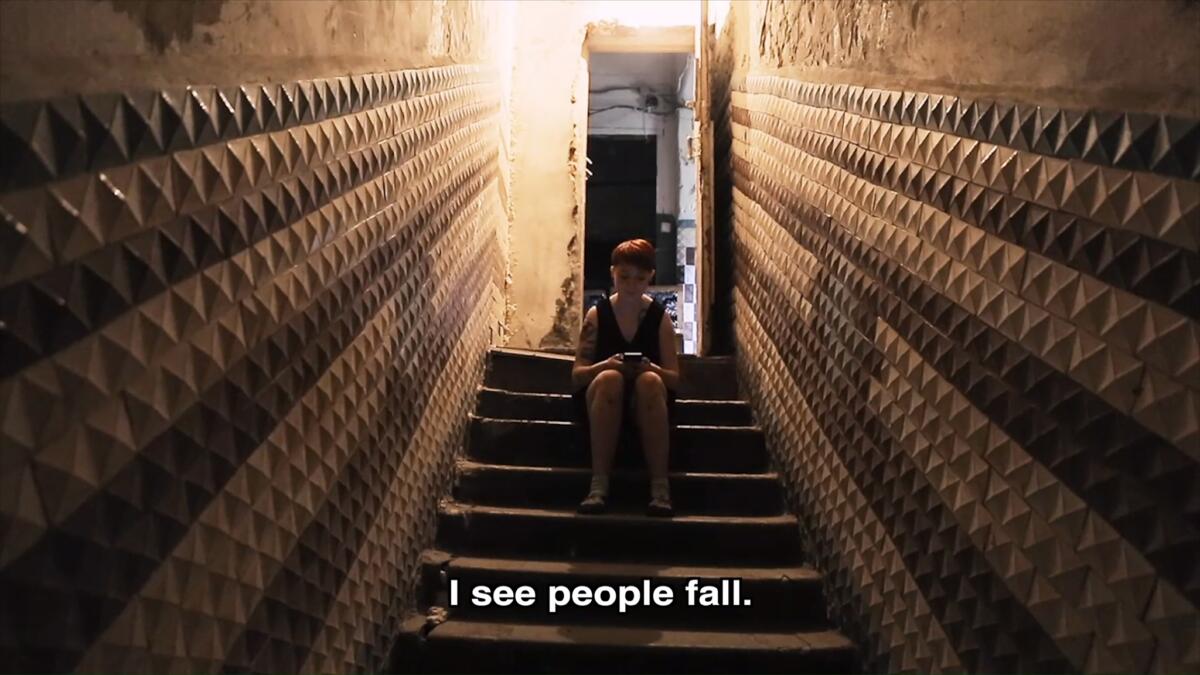

But this happened also with the film NO! NO! NO! from 2017, which was a continuation of Regular Places but not about the place again but this time more about the people. There are characters speaking for themselves. The general concept is about the distance; how you feel the war in the distance, because the war was always there, in the country, but limited to a certain territory. If you were in Kyiv you lived a normal life. I selected characters whose activities seemed very far from military involvement – they were artists and people working in creative industries, but even in their work and in their life you could feel the influence of the war. Their stories were juxtaposed with found footage videos that people from Donbas filmed from their windows, where you could see the explosions. But now, with what happened in 2022, you don’t have this juxtaposition anymore. The war literally arrived in new territories and Kharkiv has become one of these places. In that sense, something that felt like a dystopia has become reality.
AR: What does it mean for the film forms that you are using? You work a lot with collage, found footage, and images from the internet. How do you think about it now regarding the amount of images from the war that are circulating online?
MR: It is a question about the ways of representation of reality. This is also what Hito Steyerl wrote about in her essay when she used the term “documentary uncertainty.” She pointed out that the accessibility of visual information or the fixation on images of war doesn’t put us closer to that reality, it doesn’t create a better understanding or compassion. In this sense it is a problem and as an artist you have to react to that fact. You cannot be just a journalist or videoblogger. Collage, or I would say the certain filters I use in my work are important for me from this perspective. I started to think about it in 2014, it was not only Ukraine which was bombarded with rockets, but we also started to be bombarded with visual information. Any war is a war of images. You cannot trust an image anymore because it can be easily manipulated and used in the war on information.
This simple idea that the more we see the more we are blind, in the context of war images, became the starting point for the work Blind Spot (2014). I selected images from the internet that were documenting the war in Donbas and similar areas in Ukraine. They were just images of the streets, and in parallel, I was researching the phenomenon of human vision because I was interested in blindness and what kind of forms it takes in the physical process of vision. From there I learned about the blind spot phenomenon. That we don’t really see complete reality, but that there is a spot between our left and right eye which we don’t see, but our brain reconstructs from what we can see around it. We never think about it, it’s very automatic, but people start to become aware of it when they have some problem with their vision. I used it as a filter for the images that I found; it was graffiti spray and I painted it over the images. I continued this technique later using maps.
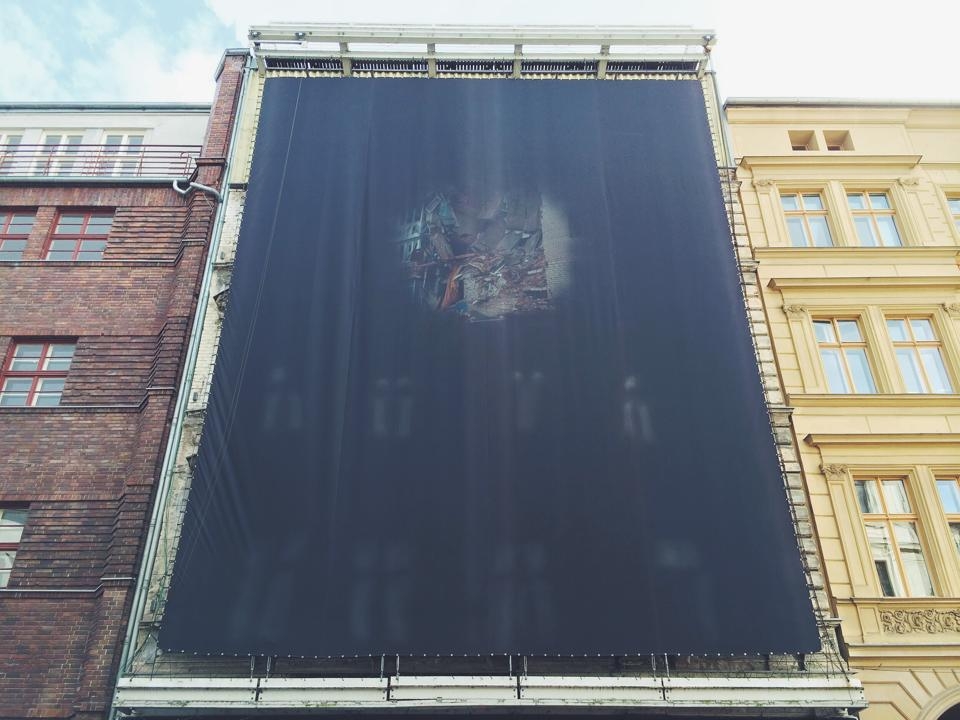


AR: I have a feeling from what you say that one of the main differences between 2014 and 2022 is that eight years ago, war images were not that present in the media and it was important to make the situation visible. But now, it is overrepresented and it is not about making it visible but rather about the question of how to talk about it.
MR: I would say that for Ukraine this is not for the first time, already in 2014 the images were overproduced. It is interesting to analyse this period in between. The work I just mentioned, Blind Spot, was a reaction to the ongoing war, which was called the frozen conflict. But it wasn’t frozen; people were still dying. But the West stopped paying attention and the war disappeared from the world media. In the continuation of this photographic series, I put together maps from Donbas with other disputed areas from Post-Soviet regions such as Transnistria or Abkhazia and South Ossetia, which are under the spotlight again because they are seen as potential sites of future threat. I produced these maps out of focus so they look like a map when you have a weak internet connection. The work is called Gradual Loss of Vision (2017). It is actually a very general contemporary media logic, based on sensationalism. I would generally say that the whole concept of TV news – and now Youtube news – is about violence. Their role is to shock people, and it is always based on information about someone else, about others. This creates a big problem – a loss of compassion. There is a term for that which is “empty empathy.”
AR: Speaking of attention, together with war there has been an increase in attention towards the Ukrainian art scene. How do you feel about it? Is there any discussion about the contemporary art scene in Ukraine happening from within?
MR: This is not new for us. Many of us already felt this in 2014 and we know how it will end. It will circulate for a couple of years and then the attention will be gone. The international art world is very cynical in this sense, it relies on the political agenda. At the same time, what can you do with it? You shouldn’t reject it because it is a possibility to say what is important to say. But you also shouldn’t need such an extreme reason as war to talk about Czech, Polish, or Romanian artists – they are a part of the European landscape. I believe that with time, the same will happen with the so called Ukrainian art scene.
AR: In your works, such as those already mentioned like Regular Places, NO! NO! NO!, and Blind Spot, you were directly commenting on the development of the situation in Kharkiv. Can you imagine reacting to the current situation around Kharkiv through art nowadays?
MR: It is hard to think about new stuff and I don’t have much desire to do that now. In the 90s there was an artistic group in Kharkiv called Fast Reaction Group (Boris Mikhailov, Vita Mikhailov, Sergey Bratkov, Sergey Solonskyi), their concept was to react in photographic performances to the political agenda of that time. They took their name from the rapid reaction forces, which is a military group. Their work had a strong influence on me when I began my activities as an artist in the 2000s. But I don’t feel the same anymore, I don’t have any desire to react immediately to something. Recently it has become important to take a certain distance and time and compare the perception when you are in Ukraine vs abroad. I never felt that I wanted to work as a political commentator, but personal involvement is important to me. I visited Kharkiv in May which was a very intense experience but it also provoked some ideas. But it needs time. The district in the north outskirts of Kharkiv where I grew up was completely destroyed, so I started to think that I have to film there and make work about my memories of the place from the time of my school years. But it is too risky now to go there. Maybe I will do it later, maybe never.
AR: Isn’t the situation better in Kharkiv now, when the Ukrainian army is pushing the Russian army further to the East?
MR: Not really, the city is constantly under attack. Actually, just yesterday (09. 09) I found out that the house in the city center where I have an apartment was damaged. Luckily it was not completely destroyed, but while commenting on ongoing events it’s always better to add “yet.”
AR: Is part of this process also the work that you actualized for the exhibition Extremely Normal in Fotograf Gallery? Your installation Facing the Wall from 2018 consists of images of fascist symbols covered partly with chewing gum. One of the highlighted works is a new photograph depicting a very new fascist symbol – the Russian “Z.” Can you elaborate more on this decision?
MR: First of all, the title Facing the Wall is important because the first association is with prosecution. At least when I hear it, I imagine a person standing in front of a wall waiting to be shot. The death penalty was eliminated in the mid 90s in Ukraine but it still exists in authoritarian Belarus. At the same, the phrase is something that can be very peaceful because it references the position of the visitor in the gallery, facing the work on the wall. The gesture of covering fascist symbols with chewing gum is a gesture of rejection, but how it is done is a play with conceptual and minimalist art from the 70s. The political meaning is then visible only when you come closer to the work. The series features a selection of European right-wing parliamentary parties and radical organisations operating in the streets. There are also symbols used by Ukrainian and Russian mercenaries who have been at war since 2014 included in the series, too. The situation changed in 2022 when I added the Russian “Z” which was initially a technical symbol to mark military equipment. But then it went viral and became an official symbol for war propaganda in Russia. “Z” means nothing, but it is a state symbol. It was not devised by some right-wing group on the streets but rather by the state. War also changed the context of Ukrainian right-wing groups because now all of them are also at the front and they are defending Ukrainian society. For example, the symbol of the Azov movement references Nazi symbols – earlier radicals related to Azov were attacking LGBTQ people, Roma, leftist activists, etc. But now it has become formalized in a military sense; new members came who are not right-wing extremists and together they formed a unit of the Ukrainian army. Their image has shifted from aggressor to defender, in particular in the city of Mariupol, where some of them were killed or taken as hostages by the Russian army.
AR: Do you think that there is also a danger in the sense that these extremist or ultranationalist groups, such as the Azov group, will become normalized when the war ends and they will become national heroes?
MR: This is a very important question. It is a question about the future. Of course, when you have such a thing as a war between nations, the rise of patriotism together with nationalism is very high. But it is also different from 2014 because back then, Ukrainian right-wing groups played a crucial role in the beginning of the war and the professional Ukrainian army was less prepared and weaker. In that sense right-wing units played a big role militarily,and that led to a right-wing reaction in peaceful cities when they tried to dictate their rules and agenda. Now many more people with very different views and backgrounds are participating in the help and volunteer organizations and also in the army and war. I know about a few leftist units in the army, there is also an LGBTQ unit which is called “Unicorn battalion”. This distorts the monopoly of the right-wing agenda. At the end of the war there will be many more people who will be equal in military experience of war. All of these people from different political backgrounds will be in competition for shaping the perception of future Ukraine.
AR: What about the local art scene? I imagine the Ukrainian art scene was quite prepared for the whole situation because you have seen the consequences of Russian aggression since 2014. What does this preparedness mean today for you and how does it look? I am interested in the modes of organization as well, what does it mean practically?
MR: The art scene was not prepared for this. No one was. I didn’t expect that the war would start at such a large scale. It was an insane decision of Putin to start this, we were expecting a certain escalation but never on such a big scale. Not even our government or public institutions – the museums didn’t have any plan B, no one was taking the possibility of war seriously, which is very tragic because some art collections are now stuck in areas occupied by the Russian army.
When the invasion started, many institutions changed their function. The YermilovCentre in Kharkiv became a shelter because it has massive concrete walls and a basement. Also different art institutions in Lviv became transit spots and shelters for people escaping the war, many artists became volunteers in these places.
And as an artist I started to receive a lot of invitations to show my works abroad when the war started, which was good because these events were very often connected to fundraising efforts and donations to help Ukrainian volunteers. In some cases, it was not easy to convince the foreign art institutions to support the Ukrainian army. Pacifism is a very common position when the war is not happening in your country and you observe it from a safe distance.
AR: After seven months how do you keep yourself focused on your work? What is helping you?
MR: I have been doing it already for a long time so I can’t imagine doing something different. As with many artists, I had doubts about my profession, how you can help in the context of war. I am not ready to fight with real weapons but I know how to make art, and I also feel that art can be a political tool. Culture is also a battlefield where you can produce political messages and be useful in this way. In the last eight years I have realized that the international audience gives a certain amount of trust to artists, a trust that politicians and journalists have lost. At the same time, many artists are intellectuals but not philosophers who use specific language that is not accessible to all people. Artists can say things in a simpler way, or their artwork can produce messaging through emotions. It has the potential to engage people in some discourse or context with emotional impact, provoking discussion, changing opinions.
Edited by Ewa Borysiewicz and Katie Zazenski
Mykola Ridnyi (born in Kharkiv, lives and works in Kyiv) is an artist, filmmaker, and curator. In 2008 he graduated from the Kharkiv State Academy of Design and Art. Ridnyi is a founding member of the artist collective SOSka group. In 2022 he curated several screening programs of Ukrainian film and video in MAXXI Rome, the Museum Folkwang Essen, the National Gallery in Sofia, and other venues. Ridnyi works across media ranging from site-specific installations and sculpture to photography and experimental films. His works have been shown in exhibitions and film festivals including Survival Kit 13 (Riga, 2022), Transmediale at HKW (Berlin, 2019), the 35th Kassel documentary film festival (2018), The Image of War at Bonniers Konsthall (Stockholm, 2017), All the World’s Futures at the 56th Venice Biennale (2015), The School of Kyiv – Kyiv Biennale (2015), and other venues.


